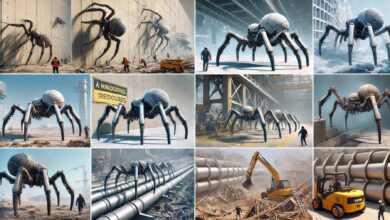Cicada Wings
How Cicada Wings Inspire Advanced Swarm Robotics for Environmental Monitoring

In the quest for innovation, nature often provides the most profound inspirations. At Tengri Space, our advanced research in swarm robotics has been significantly influenced by the natural world, particularly the intricate and efficient design of cicada wings. These fascinating insects, known for their distinctive sounds and remarkable life cycles, offer valuable insights into the development of robotic systems that can operate efficiently in atmospheric environments. This comprehensive article explores the anatomy and function of cicada wings, their biological significance, and how they inspire our cutting-edge robotics. Additionally, we will address several common questions about cicada wings to provide a deeper understanding of these remarkable creatures.
The Anatomy of Cicada Wings
Cicadas belong to the order Hemiptera and are known for their transparent, veined wings. These wings are crucial for their survival, enabling flight and communication. The structure and composition of cicada wings are marvels of natural engineering, offering both strength and flexibility.
Structure and Composition
Cicada wings are composed primarily of chitin, the same robust material found in the exoskeletons of other arthropods. This provides the necessary strength and durability for sustained flight. The wings are covered with a network of veins that provide structural support and facilitate the flow of hemolymph (insect blood). This venation pattern not only reinforces the wings but also allows for efficient distribution of mechanical stress during flight.
The surface of cicada wings is covered with microstructures that contribute to their unique properties. These microstructures can manipulate light, making the wings appear iridescent, and also have self-cleaning properties. The wings’ hydrophobic nature helps keep them free from water and debris, ensuring optimal flight performance.
Cicada Wings and Swarm Robotics
At Tengri Space, our research in swarm robotics has drawn significant inspiration from the mechanics of cicada wings. Swarm robotics involves the coordination of multiple robots to perform tasks collaboratively, much like how cicadas operate in swarms during their life cycles. The natural behavior of cicadas provides a fascinating model for understanding how decentralized systems can function efficiently without a central control unit. This decentralized approach is particularly useful in environments where individual robots need to make autonomous decisions while still contributing to the overall mission of the swarm.
Biomimicry in Robotic Design
By studying cicada wings, we have developed robotic wings that mimic their structure and functionality. These robotic wings are designed to operate in atmospheric conditions, leveraging the aerodynamic principles observed in cicadas. The microstructures on the surface of cicada wings have inspired the development of materials that are lightweight, durable, and possess self-cleaning properties. These microstructures, often referred to as nanopillars, are incredibly effective at repelling water and other contaminants, which is essential for maintaining the efficiency of the wings in various atmospheric conditions. This biomimetic approach has resulted in robotic wings that are not only more durable but also capable of performing better in adverse weather conditions.
The lightweight nature of cicada wings is another critical aspect that has been incorporated into our robotic designs. By utilizing advanced materials such as carbon fiber composites and graphene, we have been able to replicate the delicate balance of strength and lightness found in cicada wings. This allows our robots to achieve greater maneuverability and endurance, which are essential for prolonged missions in complex environments.
Enhanced Durability and Efficiency
The self-cleaning properties inspired by cicada wings are particularly beneficial for enhancing the longevity and efficiency of our robotic systems. In environments where dust, pollen, and other particulate matter are prevalent, maintaining clean surfaces is crucial for optimal performance. The self-cleaning feature ensures that the robotic wings remain free from debris, reducing the need for maintenance and prolonging the operational lifespan of the robots. This capability is especially advantageous for long-term missions where human intervention is limited or impractical.
In addition to their self-cleaning properties, the microstructures on cicada wings also contribute to their ability to resist bacterial growth. This antimicrobial feature has been replicated in our robotic designs, providing an added layer of protection in environments where hygiene is a concern. The ability to remain free from bacterial contamination is particularly important in applications such as environmental monitoring and agricultural surveillance, where the presence of harmful bacteria can skew data and compromise the integrity of the mission.
Coordinated Movements
Cicadas exhibit remarkable coordination during their mass emergences, often moving and communicating in unison. This behavior has been a model for our swarm robotics systems, where multiple robots must work together seamlessly. The study of cicada swarming behavior has provided valuable insights into how individual units can maintain coherence without centralized control. This decentralized approach allows each robot to operate autonomously while still contributing to the overall objective, enhancing the robustness and adaptability of the swarm.
The neural and muscular control mechanisms in cicadas have been particularly informative in developing algorithms for coordinated robotic movements. Cicadas rely on a combination of sensory inputs and neural processing to synchronize their actions with those of their peers. By mimicking these biological processes, we have created algorithms that enable our robots to communicate and coordinate their movements effectively. These algorithms ensure synchronized and efficient operations, even in dynamic and unpredictable environments.
Communication and Decision-Making
Effective communication is a cornerstone of swarm behavior, and cicadas provide an excellent model for this aspect of swarm robotics. Cicadas use a variety of signals, including acoustic and chemical cues, to communicate with each other during their mass emergences. These communication methods have inspired the development of advanced communication protocols for our robotic swarms. By utilizing wireless communication technologies and sophisticated data-sharing algorithms, our robots can share information in real-time, ensuring that each unit is aware of the swarm’s overall status and objectives.
Decision-making in a swarm system is another critical area where cicadas have provided valuable insights. In a cicada swarm, individual insects make decisions based on local information and their interactions with nearby peers. This decentralized decision-making process ensures that the swarm can adapt quickly to changes in the environment. By implementing similar decision-making frameworks in our robotic swarms, we have enhanced their ability to respond to unforeseen challenges and opportunities, making them more resilient and versatile.
Applications of Coordinated Robotic Swarms
The principles derived from cicada-inspired swarm robotics have a wide range of applications. In environmental monitoring, these robots can work together to cover large areas, collecting data on air quality, weather patterns, and ecological changes. Their coordinated movements ensure comprehensive coverage and minimize the risk of data gaps. In disaster response scenarios, swarm robotics can be deployed to search for survivors, assess damage, and deliver supplies. The ability of the robots to communicate and coordinate their actions enhances the efficiency and effectiveness of these operations, potentially saving lives and resources.
In agriculture, cicada-inspired robotic swarms can revolutionize how crops are monitored and managed. By working together, these robots can perform tasks such as pest detection, crop health assessment, and targeted application of fertilizers or pesticides. Their coordinated efforts ensure thorough and precise coverage, improving crop yields and reducing the environmental impact of farming practices. The integration of swarm robotics in agriculture represents a significant step towards sustainable and efficient food production.
Environmental Monitoring
In the field of environmental monitoring, cicada-inspired robots can be deployed to gather real-time data on various atmospheric conditions. Their ability to fly and navigate through complex environments allows them to access hard-to-reach areas, such as dense forests, mountainous regions, and urban canyons. These robots can be equipped with sensors to measure air quality, detect pollutants, and monitor weather patterns. Their lightweight and flexible design, inspired by cicada wings, enables them to hover and maneuver with precision, providing detailed and accurate data collection. This data is crucial for understanding environmental changes, managing natural resources, and implementing conservation strategies.
Disaster Response
Cicada-inspired robotics also hold significant potential in disaster response scenarios. In the aftermath of natural disasters like earthquakes, hurricanes, and floods, quick and efficient search and rescue operations are vital. The agility and coordination observed in cicada swarms can be replicated in swarm robotics to navigate through debris, enter collapsed structures, and locate survivors. These robots can communicate with each other to cover large areas systematically, ensuring that no region is overlooked. Additionally, their ability to operate in harsh conditions, such as smoke-filled or low-visibility environments, makes them indispensable tools for emergency responders. The deployment of such robots can greatly enhance the speed and effectiveness of rescue missions, potentially saving many lives.
Agricultural Surveillance
In agriculture, cicada-inspired robots can revolutionize how crops are monitored and managed. Traditional methods of agricultural surveillance can be labor-intensive and time-consuming. However, with the introduction of these advanced robotic systems, farmers can gain real-time insights into the health and growth of their crops. The robots can fly over fields to detect signs of disease, pest infestations, or nutrient deficiencies, allowing for timely interventions. Their precise and non-invasive navigation ensures that crops are not damaged during the monitoring process. Furthermore, these robots can assist in pollination by mimicking the flight patterns and behaviors of pollinating insects, thereby enhancing crop yields and ensuring food security.
Common Questions About Cicada Wings
Do All Cicadas Have Wings?
Yes, all cicadas possess wings. Cicadas go through a metamorphosis that includes a nymph stage and an adult stage. Once they reach adulthood, they have fully developed wings that they use for flight and communication. The wings are a defining feature of adult cicadas, distinguishing them from their wingless nymph counterparts.
How Many Wings Do Cicadas Have?
Cicadas have four wings: two forewings and two hindwings. The forewings are longer and more robust, providing the primary lift and thrust needed for flight. The hindwings are shorter and act as stabilizers, aiding in maneuverability and balance during flight. This four-winged configuration is typical of many flying insects and is essential for their aerial capabilities.
How to Preserve Cicada Wings
Preserving cicada wings requires careful handling to maintain their delicate structure. First, gently clean the wings with a soft brush to remove any dirt or debris. Next, place the wings between layers of wax paper or tissue paper, ensuring they are flat and not overlapping. Store them in a cool, dry place to prevent moisture damage. For long-term preservation, consider using a shadow box or frame to display the wings, protecting them from environmental factors.
Can a Cicada Live with a Broken Wing?
A cicada with a broken wing can survive, but its mobility and ability to perform essential functions will be significantly impaired. Flight is crucial for cicadas to find mates, escape predators, and explore their environment. A broken wing can hinder these activities, reducing the cicada’s chances of survival. In the wild, a cicada with a broken wing is more vulnerable to predation and less likely to reproduce.
Can Cicadas Grow Their Wings Back?
No, cicadas cannot regenerate their wings. Once their wings are damaged, they remain impaired for the rest of their lives. Unlike some other insects and animals that can regenerate lost or damaged appendages, cicadas lack this ability. This limitation underscores the importance of their wings for survival and the need for careful handling when studying or preserving them.
Do Cicadas Make Noise with Their Wings?
Cicadas do not make noise with their wings; instead, they produce their characteristic sounds using specialized structures called tymbals located on their abdomen. Male cicadas contract and release these tymbals rapidly, creating the loud, distinctive mating calls that cicadas are known for. The wings play no role in sound production, although they may amplify the sound by acting as a resonating chamber.
How Long Does It Take for Cicada Wings to Dry?
After a cicada molts from its nymph stage to its adult form, it takes a few hours for its wings to dry and harden. During this period, the cicada is vulnerable and unable to fly. The drying process is critical for the wings to achieve the necessary rigidity and strength for flight. Once the wings are fully dried, the cicada can take to the air, ready to fulfill its role in the ecosystem.
The study of cicada wings offers profound insights into both biology and engineering. At Tengri Space, we have harnessed these insights to develop advanced swarm robotics systems, drawing inspiration from the intricate design and functionality of cicada wings. As we continue to explore the natural world, we remain committed to leveraging biomimicry to push the boundaries of technology and innovation. Through understanding and emulating the wonders of nature, we can create robotic systems that are not only efficient and resilient but also capable of addressing some of the most pressing challenges of our time.



